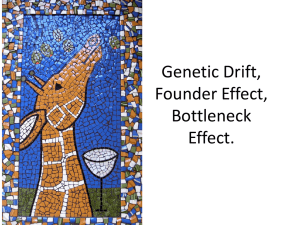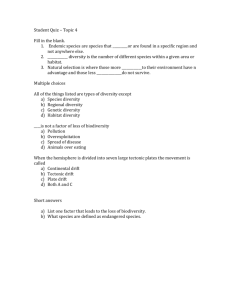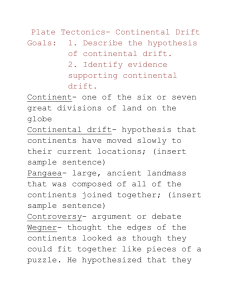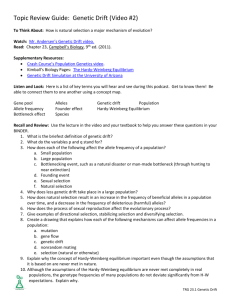Understanding the Mechanisms of Evolution (framework)
advertisement
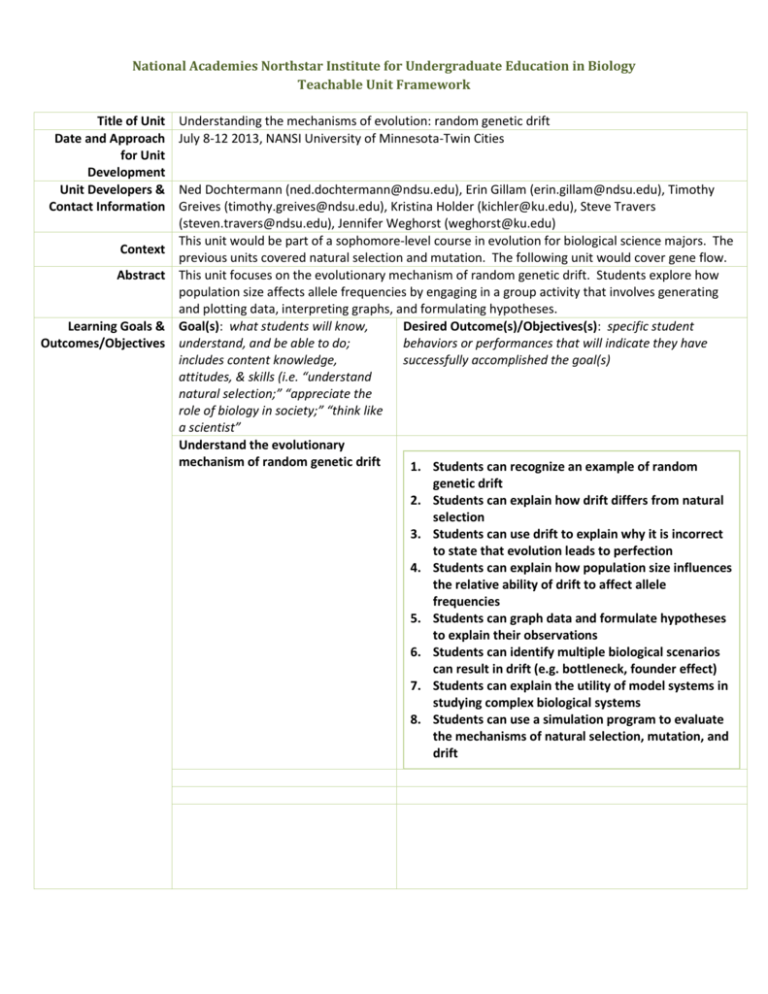
National Academies Northstar Institute for Undergraduate Education in Biology Teachable Unit Framework Title of Unit Date and Approach for Unit Development Unit Developers & Contact Information Context Abstract Learning Goals & Outcomes/Objectives Understanding the mechanisms of evolution: random genetic drift July 8-12 2013, NANSI University of Minnesota-Twin Cities Ned Dochtermann (ned.dochtermann@ndsu.edu), Erin Gillam (erin.gillam@ndsu.edu), Timothy Greives (timothy.greives@ndsu.edu), Kristina Holder (kichler@ku.edu), Steve Travers (steven.travers@ndsu.edu), Jennifer Weghorst (weghorst@ku.edu) This unit would be part of a sophomore-level course in evolution for biological science majors. The previous units covered natural selection and mutation. The following unit would cover gene flow. This unit focuses on the evolutionary mechanism of random genetic drift. Students explore how population size affects allele frequencies by engaging in a group activity that involves generating and plotting data, interpreting graphs, and formulating hypotheses. Goal(s): what students will know, Desired Outcome(s)/Objectives(s): specific student understand, and be able to do; behaviors or performances that will indicate they have includes content knowledge, successfully accomplished the goal(s) attitudes, & skills (i.e. “understand natural selection;” “appreciate the role of biology in society;” “think like a scientist” Understand the evolutionary mechanism of random genetic drift 1. Students can recognize an example of random genetic drift 2. Students can explain how drift differs from natural selection 3. Students can use drift to explain why it is incorrect to state that evolution leads to perfection 4. Students can explain how population size influences the relative ability of drift to affect allele frequencies 5. Students can graph data and formulate hypotheses to explain their observations 6. Students can identify multiple biological scenarios can result in drift (e.g. bottleneck, founder effect) 7. Students can explain the utility of model systems in studying complex biological systems 8. Students can use a simulation program to evaluate the mechanisms of natural selection, mutation, and drift National Academies Northstar Institute for Undergraduate Education in Biology Teachable Unit Framework Incorporation of Scientific Teaching Themes Active Learning How students will engage actively in learning the concepts Assessment How teachers will measure learning; how students will self-evaluate learning Activities in class before tidbit: Pre-assessment clicker questions that ask questions about evolution, natural selection, and mutation Pre-assessments (Outcome 1,2): Responses to the clicker questions will indicate if students grasp the major concept from the previous lecture (natural selection and mutation) Discussion of Huntington’s disease (HD) in the Dutch population that migrated to South Africa Diversity How the unit is designed to include all participants Groups develop hypotheses about the high rates of HD in South African immigrants. Responses will provide evidence about their understanding of evolutionary mechanisms Activities during tidbit: Students sample from a population of haploid, sexually reproducing organisms, creating a small “founder” population from a larger “source” population Tidbit assessments (Outcome 3,4,5,6,7): Students plot their data Students demonstrate whether they can effectively derive frequencies of a phenotype and accurately plot the data Discussion 1: Did everyone get 50:50? Who got more orange? More blue? Anybody have just one color? If we extend this out several generations, what do you think will happen? Group responses reflect that students understand that founder populations are not always the same, and are not necessarily reflective of phenotype/allele frequencies in the source population Discussion 2a: Look at your graph, what happened to the frequency of orange over time? Is this evolution? Group responses reflect that students understand that change over time in a founder population is ultimately constrained by the phenotype/allele frequencies of the founder population Discussion 2b: Look around the room – how does your data differ from those collected by other groups? Why might this be? Group responses reflect that students understand that change over time in different founder populations can be highly variable due to different starting conditions in the founder populations. Diversity in the tidbit: We will provide verbal and written instructions about the tidbit activity Students work in a group setting. This includes cooperating to complete the activity, as well as talking about the discussion questions in a group as well as with the whole class National Academies Northstar Institute for Undergraduate Education in Biology Teachable Unit Framework Discussion 2c: Was there selection? Focus on one graph that goes to (or near) fixation Group responses reflect that students understand that fixation of a phenotype/allele does not necessarily mean selection is occurring, but rather that it can be a product of phenotype/allele loss when a small founder population is established from a larger source population. Discussion 4: Return to Dutch example, tie in results from M&Ms activity, show full graph with incidence of HD in native South Africans. At this point, the term “founder effect” is introduced. Students conclude that the incidence of HD in Afrikaners is not adaptive, as there is no increased incidence of this disease in native South Africans. Instead, this is an example of random genetic drift. Activities after class Homework assignment using simulation program Next class: Discussion of homework Next class: Case study: Conservation genetics of Cape buffalo. The concept of a bottleneck is introduced. Post-tidbit assessment (Outcomes 3,4,5,6,7,8): Students can understand how adjusting the parameters of drift (starting population size) and selection (fitness differences between alleles) impact the evolution of population Students conclude that multiple biological scenarios can result in small population sizes that are strongly affected by drift. Students are exposed to the concept of drift through action (collecting data in class, manipulating variables during simulations and writing (summarizing their answers when responding to the homework questions). Reading could also be accommodated by incorporating a post-unit reading of the textbook or a foundational paper, such as Dobzhansky and Pavlovsky (1957) National Academies Northstar Institute for Undergraduate Education in Biology Teachable Unit Framework Sample Presentation Plan (detailed schedule with approximate timing for unit) Session 1 Pre-class Previous unit should have covered mutation and natural selection 10 minutes Start of class: clicker quiz reviewing concepts of natural selection - formative assessment 8 minutes Introduction of the pattern of the frequency of Huntington’s disease worldwide vs. Afrikaners Students discuss and formulate hypotheses 35 minutes M&M activity 1. introduction of activity, taking time to distinguish it from the Huntington’s example - give students time to read instructions - outcome 7 2. students follow directions to create splinter populations, begin recording data and graphing their results - discussion of their results so far and why not everyone got a frequency of 50% - students make predictions about how frequencies will change if the population size is constrained for multiple generations - formative assessment - outcome 4, 5 3. students continue following directions to produce a total of 5 generations, recording the data and graphing their results discussion of results highlighting: - drift is a mechanism of evolution - differences with natural selection - formative assessment - outcome 1, 2, 5 12 minutes Follow up on Huntington’s disease – discuss the example of Huntington’s disease in light of the exercise on drift Discussion should include National Academies Northstar Institute for Undergraduate Education in Biology Teachable Unit Framework - how might students want to modify their initial hypotheses - additional information to distinguish drift and natural selection - explicit description of the Huntington’s example as a founder effect - formative assessment - outcome 1, 2, 3, 6 9 minutes Introduction of simulation program, run simulation with larger population size and have students discuss the difference between the simulation results and their M&M results. - PopG can be downloaded at: http://evolution.gs.washington.edu/popg/ - formative assessment - outcome 4, 5, 8 1 minute Assign homework that will involve students using the simulation program and explaining the differences in the results due to the effects of selection and drift - summative assessment - outcome 2, 4, 5, 8 Add additional activities information as needed for the unit. Session 2 Pre-class Homework assignment completed In Class - Formative assessment (clicker questions) focused on simulation results. - Discussion of homework - Could present a modification of a graph from the Dobzhansky and Pavlovsky (1957) paper and ask students to interpret the data and develop hypotheses. Modified graph can be found at: http://www.blackwellpublishing.com/ridley/az/Genetic_drift.asp - Discuss conservation case study demonstrating a bottleneck in cape buffalo - Outcomes 1-8 Resources for Teaching the Unit National Academies Northstar Institute for Undergraduate Education in Biology Teachable Unit Framework (other files and information needed/helpful to teach the unit, including files for papers from which original data for class activities is taken, supporting information for the instructor, handouts, in class activities materials, assessments with answer keys, homework assignments, etc.) 1. 2. 3. 4. 5. Activity data sheet Activity instruction sheet PowerPoint presentation to accompany the activity and discussions Tidbit agenda Potential post-unit readings: a. Dobzhansky T & Pavlovsky O. 1957. An experimental study of interaction between genetic drift and natural selection. Evolution 11: 311–319. b. Heller R, Okello JBA, Siegismund H. 2010. Can small wildlife conservancies maintain genetically stable populations of large mammals? Evidence for increased genetic drift in geographically restricted populations of Cape buffalo in East Africa. Molecular Ecology 19: 1324-1334. Summary of Origin of the Idea We decided to focus on this topic because students are usually able to understand the concept of natural selection fairly easily, but they often struggle with the concept of drift and the concept that differences they observe in nature can be driven by random processes. As a result, we felt it would be useful to develop an activity that lays out the tenets of random genetic drift, addresses common misconceptions, and strengthens critical scientific skills, such as developing hypotheses, collecting data, and interpreting results. Summary of Feedback We benefitted from helpful comments from colleagues. Constructive feedback included the following comments/suggestions: There were many positive comments about the M&M activity: participants found it fun, memorable, and useful for conveying important concepts. Having small groups (2-3 students) would help ensure that everyone fully participates, but larger groups still involve everyone by passing the cups from person to person. It was suggested that giving students instructions for only the first phase of the activity, discussing the initial results, and then giving them further instructions might allow a more natural flow to the activity and would eliminate some groups’ having to wait for other groups. This strategy would also reduce the amount of reading required at one time and therefore be more inclusive for students who read slowly. Several reviews remarked that the large-group discussion during and following the activity was very helpful for processing the results and clarifying the conclusions students should reach. However, they National Academies Northstar Institute for Undergraduate Education in Biology Teachable Unit Framework pointed out that large-group discussion doesn’t effectively assess whether all students have achieved the learning goals. Additional formative assessment such as clicker questions would be useful to gauge success and/or reveal persistent misconceptions. One possibility would be to ask a clicker question after the introduction of the Huntington’s case study and then ask the same question at the end of the class discussion. The instructor should be prepared to discuss with students how social and political factors in colonial South Africa affected interactions (and allele frequencies) between Afrikaners and non-Afrikaner South Africans. If discussed appropriately, addressing apartheid and its ramifications could add a powerful element to this activity. Acknowledgements Thanks to Catherine Kirkpatrick and Steven Ralph for being our team facilitators and providing critical feedback throughout the entire process of developing this teachable unit.
